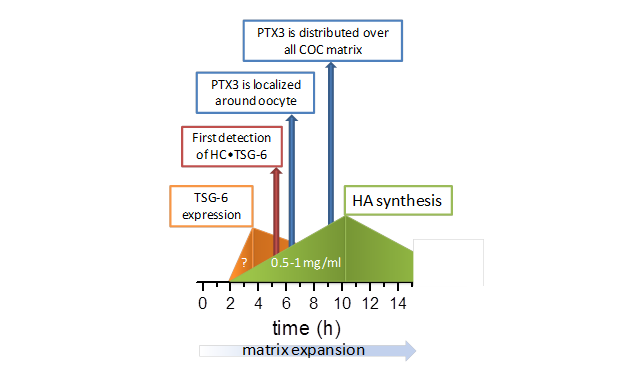COC matrix formation is an illustrative case of spatio-temporal regulation of self-assembly. Because oocyte and cumulus cells are located in a special cavity, there is a spatial distribution of the crucial proteins : IαI is circulating in the blood and diffuses into the ovarian follicle only after initiation of ovulation, when the permeability barrier becomes leaky Powers et al., 1995Hess et al., 1998. In contrast, TSG-6 and PTX3 are produced by cumulus cells around the oocyte. The time required for IαI to diffuse towards oocyte remains unknown, but the first HA•HC complexes were detected only 6 h after the initiation of ovulationChne et al., 1996Chen et al., 1992.
The expression of TSG-6, PTX3 and HA-synthases was found to have similar temporal profilesSalustru et al., 1989Mukhopadhyay et al., 2001Salustri et al., 2004Jessen & Odum, 2003. TSG-6 was found to be homogeneously distributed throughout the matrix from the periphery of the cumulus cells to the zona pellucida Carrette et al., 2001. Cells in a close proximity to the zona pellucida produce more PTX3 Scarchilli et al., 2007. Thus, PTX3 distribution is spatially heterogeneous. A gradient of PTX3 was found to be preserved even 6h after initiation of ovulation. The gradient of PTX3 also correlates with another feature indicating a radial heteroreneity in the organization of the COC matrix : HA chains close to the oocyte are more packed than in the matrix periphery Scarchilli et al., 2007.

Such a spatio-temporal organization may be crucial for the regulation of HA/protein interaction and for the correct assembly of the COC matrix (Figure 9).
